September 27, 2024
Air Date: September 27, 2024
FULL SHOW
SEGMENTS
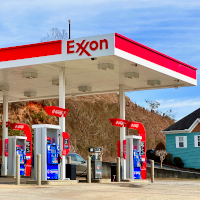
Exxon's Alleged Plastics 'Deception'
View the page for this story
California is suing ExxonMobil over the oil giant’s alleged “campaign of deception” to convince the public that recycling is a viable solution for plastic waste, when less than 10% of plastics are recycled. Pat Parenteau, emeritus professor at Vermont Law and Graduate School, joins Host Aynsley O’Neill to discuss the lawsuit and the plastic waste crisis. (08:34)
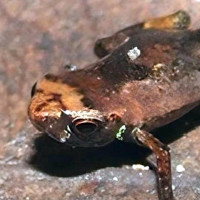
World's Smallest Vertebrate: Note on Emerging Science
View the page for this story
The Brazilian flea toad is only about a quarter of an inch long, making it the smallest vertebrate known to Western science. Its feet are so small that they have just two toes as opposed to the usual five on larger frogs and toads, Living on Earth’s Don Lyman reports in this note on emerging science. (01:23)

AI Gobbles Water and Energy
View the page for this story
Artificial intelligence is now capable of writing entire books that are coherent, but it takes tremendous amounts of water and energy to make the billions of calculations even basic queries can require. Shaolei Ren, Associate Professor of Electrical and Computer Engineering at UC Riverside joins Host Aynsley O’Neill to discuss concerns about resource-intensive AI systems and possibilities for improvement. (08:42)
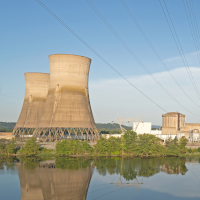
Three Mile Island to Power AI
/ Evan HalperView the page for this story
To meet the energy needs of artificial intelligence Microsoft has inked a major power purchase deal with the owners of Three Mile Island in Pennsylvania. A nuclear power reactor there underwent a partial meltdown in 1979. Its unaffected twin reactor operated until 2019 and would provide a carbon-free source of power. Evan Halper reports on the energy transition at the Washington Post and joins Host Jenni Doering to explain the hurdles of getting the shuttered nuclear power plant back online. (10:55)
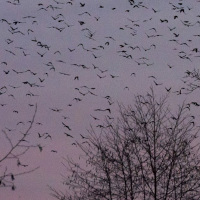
BirdNote®: The Crows' Night Roost
/ Ashley AhearnView the page for this story
Crows are social creatures that can gather by the thousands in night roosts. BirdNote®’s Ashley Ahearn reports that these gatherings may provide benefits like warmth, protection from predators, and a chance to find a mate. (02:07)
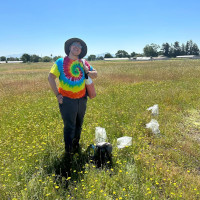
Risks for Transgender Field Scientists
View the page for this story
For students and scientists who are transgender or gender nonconforming, field research can bring unique challenges and risks. Dr. Ezra Kottler, a conservation scientist and founder of the Transgender and Gender Nonconforming Field Alliance, joins Host Jenni Doering to describe how institutions can help ensure field research settings are safer and more inclusive of trans people. (12:11)
Tree Swallow Funnel
/ Mark Seth LenderView the page for this story
One of the smallest and most agile migrating birds is the tree swallow. Living on Earth’s Explorer in Residence Mark Seth Lender marvels at how these little fliers gather in huge airborne displays as they prepare for the fall migration. (02:59)
Show Credits and Funders
Show Transcript
240927 Transcript
HOSTS: Jenni Doering, Aynsley O’Neill
GUESTS: Evan Halper, Ezra Kottler, Pat Parenteau, Shaolei Ren
REPORTERS: Ashley Ahearn, Mark Seth Lender, Don Lyman
[THEME]
DOERING: From PRX – this is Living on Earth.
[THEME]
DOERING: I’m Jenni Doering
O’NEILL: And I’m Aynsley O’Neill.
California sues oil giant Exxon over alleged deception about plastic recycling.
PARENTEAU: So, the lawsuit alleges that less than 10% of the advanced recycling is actually recycled. They can't make the claim that they found this breakthrough. That means we aren't going to have plastic waste anymore. That's the problem.
DOERING: Also, Microsoft inks a deal to restart Three Mile Island.
HALPER: Nuclear power suddenly has great interest in the tech industry because it creates power emissions free, and because there's so much trouble getting enough wind and solar online to meet these surging energy demands, in large part because of AI the tech companies are scrambling to find as much zero emissions energy as they can.
DOERING: That and more this week on Living on Earth—stick around!
[NEWSBREAK MUSIC: Boards of Canada “Zoetrope” from “In A Beautiful Place Out in The Country” (Warp Records 2000)]
[THEME]
Exxon's Alleged Plastics 'Deception'

Although Exxon is known for selling gas and oil, they also manufacture plastic. (Photo: Harrison Keely, Wikimedia Commons, CC BY 4.0)
DOERING: From PRX and the Jennifer and Ted Stanley Studios at the University of Massachusetts, Boston, this is Living on Earth. I’m Jenni Doering.
O’NEILL: And I’m Aynsley O’Neill.
Despite the takeoff of curbside recycling over fifty years ago, these days less than 10% of the world’s plastic waste actually ends up getting recycled. The rest ends up in landfills, or as pollution in the natural environment, or in our own bodies in the form of microplastics. In response to this plastics crisis, California is suing oil giant ExxonMobil in state court, alleging that Exxon deceived the public about the ability to recycle plastic that was made from its fossil fuels. Of particular issue is Exxon’s promotion of so-called “advanced” or chemical recycling, which claims to be able to turn hard-to-recycle plastics into new products but has not lived up to those promises. Joining us now to talk about the lawsuit is Pat Parenteau, former EPA regional counsel and emeritus professor at Vermont Law and Graduate School. Welcome back to Living on Earth, Pat!
PARENTEAU: Thanks, Aynsley, nice to be with you.
O'NEILL: So, Pat, what are the key takeaways from this California lawsuit against ExxonMobil?
PARENTEAU: So, this is a landmark case, because it's the first time a state attorney general has actually sued an oil company, of course, ExxonMobil, in this case, for plastic pollution. So there have been lawsuits brought against companies that sell products in plastic containers like Pepsi and Keurig coffee cups. So, we know that there have been lawsuits challenging the way that companies have characterized their recycling, but this is the first time any state has actually gone after the oil company itself.
O'NEILL: And what exactly is California asking the courts to do here?
PARENTEAU: They're asking a lot. Their main claim is that ExxonMobil is creating a public nuisance. This may sound familiar because it's also one of the claims in the climate liability cases that we've talked about over time, but they've also alleged unfair business practices, false advertising, violations of water quality. Because, of course, the plastics ends up in the water. They end up in the ocean. They end up in human beings with microplastics. So, they've got a long list of claims and requests for injunctions prohibiting the company from making false claims that they've alleged in the complaint and creating an abatement fund to deal with the plastic pollution along the California coast and elsewhere. So, lots of things contained in this lawsuit.
O'NEILL: Now, Exxon claims that it's able to take plastic waste and turn it into new products via so called advanced or chemical recycling. Pat, why doesn't California buy that argument?
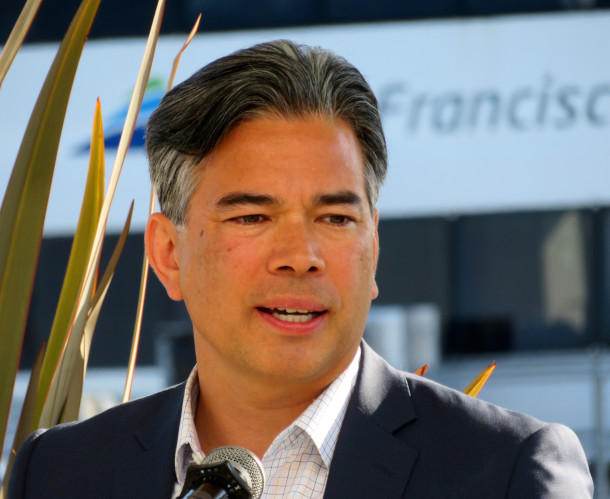
ExxonMobil faces a lawsuit from California Attorney General Rob Bonta regarding their claims about plastic recycling. (Photo: Pi.1415926535, Wikimedia Commons, CC BY-SA 3.0)
PARENTEAU: So, the lawsuit alleges that less than 10% of the advanced recycling is actually recycled. And so, if Exxon wants to say, “we are experimenting with ways to reuse these plastic products,” that would be perfectly all right, but they can't make the claim that they found this breakthrough that means we aren't going to have plastic waste anymore. That's the problem.
O'NEILL: And now this lawsuit is just in California, but I do know that California can also often set a standard for the rest of the United States to sort of follow after the fact. What do you think this could have as a national impact, if California wins in this?
PARENTEAU: I think some of the usual, as we like to say, the usual suspects, meaning New York, Massachusetts, Connecticut, Minnesota, these are progressive, blue, if you will, states with attorneys general that are very aggressive in enforcing environmental law, bringing climate lawsuits. So, I think we're going to see a ripple effect of these other major states that have already sued oil companies for their deception regarding climate change and the fact that they're not really reducing emissions the way they say they are. They're going to make those same kind of claims with respect to plastic pollution and the lack of really effective efforts at recycling. So, the same kind of states that have led the charge on climate, I think we can begin to see them doing the same thing on plastics.

Pat Parenteau is a professor at Vermont Law and Graduate School. (Photo: Vermont Law and Graduate School)
O'NEILL: There's a chance that this could go all the way to the Supreme Court. How do you think that the case would fare there at the Supreme Court, especially given the conservative lien that the court has right now?
PARENTEAU: Yeah, I mean, one of the claims that ExxonMobil is going to make is that this is an infringement on their First Amendment rights. The Supreme Court has said that corporations, just like you and I, have first amendment rights to commercial speech and political speech. So, I've already seen out of the Exxon spokespersons a signal that they are going to press very hard that what the state is really doing here is trying to tell them how to do business and what they can say about their products and infringing on their First Amendment rights to advocate for recycling if they think it really can work. So that's the kind of issue that might attract the attention of the Supreme Court with its ultra conservative majority. On the other hand, there are a number of justices on the court who've upheld state laws. Even some of the most conservative justices, like Gorsuch and Thomas, are very strong states’ rights sort of leaning justices, and so it may be, if the case actually does get all the way to the Supreme Court that the court will have a harder time overruling the states attempting to enforce state laws dealing with consumer protection, dealing with false advertising and so forth. It would be a major precedent setting case if the Supreme Court decides that the First Amendment is really implicated in these cases.
O'NEILL: So often this plastics problem is presented as a sort of consumer choice issue. You know, people just need to make the better choice. They need to choose glass packaging, or they need to be extra diligent about recycling, and all of those are great steps, but it's not able to solve the full problem on its own. So how might this lawsuit help reframe the plastics issue, do you think?
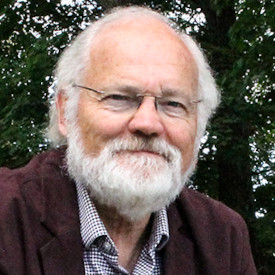
Parenteau believes that the case against ExxonMobil could have impacts in other states around the country. (Photo: Vermont Law and Graduate School)
PARENTEAU: Well, let's hope that if it's successful, the effort to find substitutes that not only don't rely on plastics, but remember, the source of all this is fossil fuel. It's oil, and it's the oil companies realizing that at least at some point they'll be out of the business of providing fuel for electricity and transportation, but they're going to have to find other uses of oil in other products, namely, plastics. So, the real challenge here is it's a systemic problem. It's the way that we live. It's not a matter of lowering quality of life. It's a matter of living differently and demanding substitutes for products that we know are causing environmental harm, and hopefully there'll be entrepreneurs who see the opportunity to develop those kinds of substitutes and different packaging, different products, and a true closed cycle system where we don't have waste at all. That's a long way down the road, I'm afraid, but it's the kind of thinking that's necessary to get us out of this. We've got to find new ways of thinking about the way we live, the way we use resources, and being much more efficient in trying to get to this closed loop system where you just don't have all this waste.
O'NEILL: Pat Parenteau is a former EPA Regional Council and emeritus professor at Vermont Law and Graduate School. Pat, as always, thank you for taking the time with us today.
PARENTEAU: It's always good to be with you.
O’NEILL: An ExxonMobil spokesperson provided a statement in response to the lawsuit that reads in part: “For decades, California officials have known their recycling system isn't effective. They failed to act, and now they seek to blame others. Instead of suing us, they could have worked with us to fix the problem and keep plastic out of landfills.” The full statement is on the Living on Earth website, loe dot org.
ExxonMobil Spokesperson Statement:
“For decades, California officials have known their recycling system isn’t effective. They failed to act, and now they seek to blame others. Instead of suing us, they could have worked with us to fix the problem and keep plastic out of landfills. The first step would be to acknowledge what their counterparts across the U.S. know: advanced recycling works. To date, we’ve processed more than 60 million pounds of plastic waste into usable raw materials, keeping it out of landfills. We’re bringing real solutions, recycling plastic waste that couldn’t be recycled by traditional methods.”
Related links:
- Learn more about Pat Parenteau
- Read Inside Climate News’ article about the lawsuit against ExxonMobil
- Explore Rob Bonta’s press release
[MUSIC: Joey DeFrancesco, “Soul Dancing” on More Music, Mack Avenue Records II, LLC]
World's Smallest Vertebrate: Note on Emerging Science
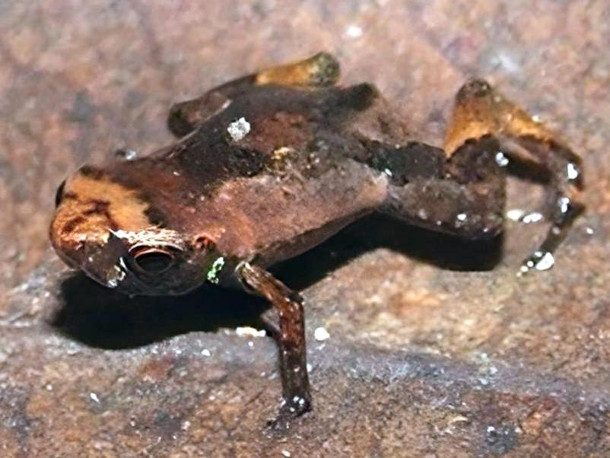
The Brazilian flea toad (Brachycephalus pulex) averages mere millimeters in length. (Photo: Person Who Took Photo, Person’s Organization If Applicable, Website Where You Got Photo, CC Copyright info)
O’NEILL: Coming up, AI’s growing hunger for energy and water. But first this note on emerging science from Don Lyman.
[SCIENCE NOTE THEME]
LYMAN: In a scientific paper published early this year, herpetologist Mirco Sole and his colleagues at State University of Santa Cruz in Brazil, described what they say is the world’s smallest know amphibian and the smallest known vertebrate – Brachycephalus pulex, aka the Brazilian flea toad.
The males of the tiny amphibians averaged 7.1 mm long, or slightly over a quarter of an inch, while the females averaged 8.15 mm in length. The smallest male flea toad was just 6.45 mm long. These miniscule creatures could sit comfortably on a dime, which is 17.91 mm in diameter.
The Brazilian flea toad has nabbed the title of world’s smallest known amphibian and smallest known vertebrate. At just 7 millimeters long on average, the frogs are a fraction the size of a 27-millimeter-wide $1 Brazilian real coin.https://t.co/KBIEiPEIcd
— Science News (@ScienceNews) March 3, 2024
The scientists said being so small does affect the body structure of the flea toad. For example, their tiny feet have just two toes, as opposed to the usual five toes on the feet of larger frog and toad species.
Solé said there may be even smaller vertebrates that have yet to be discovered, but any that are less than about six millimeters long “would really challenge morphology and physics, but who knows.”
With the shortest known science note, I’m Don Lyman.
Related link:
Smithsonian Magazine | “The World’s Smallest Vertebrate Is a Tiny Brazilian Frog, Study Finds”
[SCIENCE NOTE THEME]
ANNOUNCER: Support for Living on Earth comes from Sailors for the Sea and Oceana. Helping boaters race clean, sail green and protect the seas they love. More information @sailorsforthesea.org.
[CUTAWAY MUSIC: Joey DeFrancesco, “Soul Dancing” on More Music, Mack Avenue Records II, LLC]
AI Gobbles Water and Energy

According to researchers at the University of California Riverside a 100 word email generated by an AI chatbot consumes 519 millimeters of water which is a little more than a bottle of water. (Photo: Markus Spiske, Unsplash, Fair Use)
DOERING: It’s Living on Earth, I’m Jenni Doering.
O’NEILL: And I’m Aynsley O’Neill.
Artificial Intelligence has become a part of everyday life, but there’s little regulation thus far of the deployment and use of AI. And currently, there’s no law on the books in the US that requires AI companies to disclose their environmental impact in terms of energy and water use. So, concerned researchers rely on voluntary data from companies like Apple, Meta, and Microsoft. But research is showing that AI generation may be even more resource-intensive than originally thought. Imagine that you want to ask an AI program to write up a one-hundred-word email for you. You get an almost instant response, but what you don’t see are the intensive computing resources that went into creating that email. At the AI data center, generating just two of those emails could use as much energy as a full charge on the latest iPhone. And according to a Pew Research Center study, that 100-word email could use up a whole bottle of water for the cooling that’s needed at these data centers. Here to talk more about AI’s energy and water consumption is Shaolei Ren, Associate Professor of Electrical and Computer Engineering at the University of California, Riverside. Welcome to Living on Earth Shaolei!
REN: Thanks for having me.
O'NEILL: For those of us who are unfamiliar with the technical aspects of how AI works, why does it take so much more energy and so much more water than anything else you do on your computer?
O'NEILL: Well, because a large language model is by definition, it's just really large. And what we mean by large is that each model has like several billions of parameters, or even hundreds of billions of parameters. And roughly, if you, let's say you have 10 billion parameters to generate one token or one word, you're going to go through 20 billion calculations. And so, you think about that, you need to press your calculator for 20 billion times. So that's really, really very energy intensive process. And this energy is converted into heat, so we need to get rid of the heat. And water evaporation is one of the most efficient way to cool down the data center facilities. So that's why we also use a lot of water besides the energy. And here, by consumption is what we mean, is the water evaporated into the atmosphere. So sometimes that's considered as a lost water, although it technically is still within our global water cycle system, but it's not available for reuse in the short term in the same source. So, water consumption is really the difference between the water withdrawal minus the water discharge, and that's very different from the water that we use to take a shower. So, when you take a shower, you withdraw a lot of water, but there's not much consumption.
Excited to share our “AI Water” paper has been accepted by Communications of the ACM, the most impactful ACM publication (by IF metric). The peer review took 7 months, but it’s so rewarding to see comments & recognition from the anonymous reviewers! https://t.co/mvvKJTU8CM
— Shaolei Ren (@renshaolei) July 3, 2024
O'NEILL: And from what I understand, in the United States, at least, the water that's used in these AI data centers to do this cooling comes from local or municipal sources. What impact does an AI data center have on the local community around it?
REN: Well, yeah it uses a lot of water from the local municipals and basically, in the US, roughly 80 to 90% of the water consumption for data centers is coming from the potable water sources. And there's not much information or official estimate, but we did some preliminary study, and it shows that currently in the US the data centers water consumption is already roughly two to 3% of the public water supplies, water consumption. So here we're talking about a consumption, not water withdrawal. So basically, that's the evaporated water into the atmosphere. And based on the estimate by EPRI for the future AI energy demand by 2030 this number could go up to 8%. So, I think that's really a lot.
O'NEILL: And there's this ongoing debate in Memphis, where tech billionaire Elon Musk is trying to build a massive server to accommodate AI. And the local utility estimates that this system is going to need something like a million gallons of water per day to cool it. From your perspective, how should local communities weigh the benefits versus the cost of having these local AI data centers?

Computing infrastructure is a high consumer of user water and power. Pictured above is a data center in Virginia Tech University. (Photo: Christopher Bowns, Wikimedia Commons, CC BY-SA 2.0)
REN: I think, of course, there are benefits, especially in terms of the economic development. For example, the data center construction will bring some tax revenues, and after the completion, there will be a steady stream of tax dollars for the local government. But on the other hand, the natural resources, as you mentioned, millions of gallons of water a day could be an issue. Right now, I heard that the local water utility says it just takes up, like 1% of the total water supply. But I would say probably they are comparing water consumption with the water withdrawal, because they supply the water to residents, to other industries, but those usage is mostly water withdrawal because they just return the water immediately back to the supply. However, when data center takes the water, they're just evaporating water, most of the water will be evaporated. So, I think it's not really the right metric to compare when they say 1%. So, we need to have like the same metric when we do the comparison. This 1% water withdrawal by data centers could mean that the water consumption is roughly 5 to 10%.
O'NEILL: And now Professor the companies that created and operated these AI systems, they themselves have an interest in making the technology more efficient. So, what kind of possible improvements in AI technology could make it more energy or water efficient over time?
REN: Right, so they definitely have the incentive to reduce the energy consumption, reduce the resource consumption for training and inference. And we actually have seen a lot of research proposals and solutions that promise to reduce the energy consumption, but it turns out that in reality, the systems are not that optimized. Because I saw a paper from a top tech companies research team and it shows that the energy consumption is like 10 times higher than what we thought before, even though they're using state of the art optimization techniques. So, right, they do have the incentive to reduce the energy and resource usage for AI computing. However, the real world is a different story, and partly because they have strict service level objective to meet, which means they need to return the responses to users in a short amount of time and that sort of limits how well they could optimize their system. If they are just doing batch processing, yeah, they could be very energy efficient, but it turns out, in reality, there are a lot of constraints which prohibits them from using those optimization techniques. So maybe we can compare the bus versus a car, a passenger car. So, in general, per passenger wise, the bus should be more energy efficient than a passenger car, assuming the bus is fully loaded. But in reality, due to the user request random patterns and some other constraints the bus is not fully loaded at all. So, if you have like 50 passenger bus, usually it's just loaded for five passengers, and on average per passenger, fuel efficiency is much worse than the passenger car.
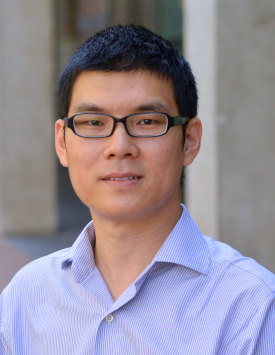
Shaolei Ren is an Associate Professor of Electrical and Computer Engineering at the University of California, Riverside. (Photo: Courtesy of Shaolei Ren)
O'NEILL: AI has become a really immense part of many people's day to day lives. It's supposed to make our lives easier, but it comes at this sort of tremendous cost to the environment. What's the solution here? If the technological advances aren't working out the way we're hoping they will, what's the fix?
REN: I think one of the potential fixes is, instead of using larger and larger models we could be using smaller and smaller models, because usually those smaller models are good enough to complete many of the tasks that we actually care about. For example, if you just want to know the weather, want to know some summary of text, using smaller model that's usually good enough. And using smaller model means you're going to save a lot of lot of resources and energy consumption. And sometimes you could even render small models on your cell phone, and that can further save the energy by, say, 80% very easily, compared to running a larger model on the on the cloud.
O'NEILL: Shaolei Ren is an Associate Professor of Electrical and Computer Engineering at the University of California Riverside. Professor, thank you so much for taking the time with me today.
REN: Thanks for having me.
Related links:
- The Washington Post “The Hidden Environmental Cost of Using AI Chatbots”
- Fortune “AI Doesn’t Just Require Tons of Electric Power. It Also Guzzles Enormous Sums of Water.”
- Bloomberg | “In Memphis, an AI Supercomputer from Elon Musk Stirs Hope and Concern”
- The Atlantic | “AI is Taking Water from the Desert”
- Yale Environment 360 | “As Use of A.I. Soars, So Does the Energy and Water It Requires
[MUSIC: Parcels, “Lightenup” on Parcels, Because Music]
Three Mile Island to Power AI
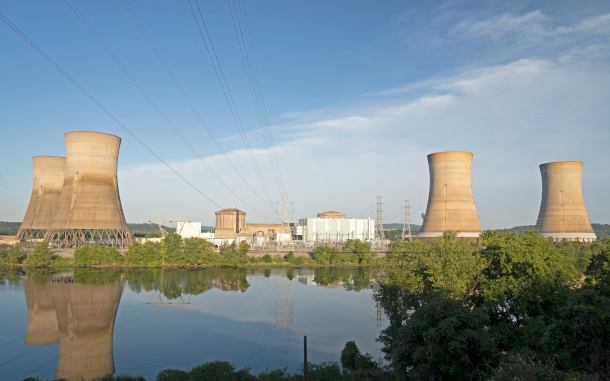
The deal between Microsoft and energy supplier Constellation would reopen Unit 1 of the Three Mile Island nuclear plant. (Photo: Dave Monteverdi, Flickr, CC BY-NC-ND 2.0)
DOERING: Propelled by the AI boom, tech giants are hunting for new ways to feed AI’s insatiable appetite for energy. And Microsoft is betting big that zero-emissions nuclear power could be the answer. The company has inked a major deal with the owners of the plant that had the most serious nuclear power incident in US history. In 1979 the Three Mile Island nuclear plant along the Susquehanna River in Pennsylvania experienced a partial meltdown of one of its two reactors. A malfunction of the cooling pumps combined with operator error led to the overheating of the reactor core and a small release of radioactive material. No one died in the immediate aftermath and the U.S. Nuclear Regulatory Commission estimates that the roughly 2 million people in the area received on average just a fraction of a chest x-rays worth of radiation. But the failure of Unit 2 at Three Mile Island became a symbolic touchstone for the anti-nuclear movement. The other reactor at Three Mile Island kept operating up until a few years ago, when the regional grid became flooded with cheaper energy from gas-fired power plants. Three Mile Island is still hooked up to the grid but with the addition of all that gas power, upgrades to the grid may be needed to bring the nuclear plant back online as soon as 2028. Evan Halper is a business reporter at the Washington Post who covers the energy transition, and he joins me now. Evan, welcome to Living on Earth!
HALPER: Thanks for having me. Great to be here.
DOERING: So, Evan, I wasn't around back then, but I do know that in 1979 the Three Mile Island accident fueled an intense wave of anti-nuclear protests across the country. What has been the public reaction to the possibility of reopening this plant now?
HALPER: It's very mixed. This is not the 1970s. We're not seeing a, you know, an outpouring of protest. We are seeing some protest, but we're also hearing from a lot of politicians in the community who are saying, you know, this plan is an economic anchor. These are really good paying jobs, and then there's all kinds of ancillary jobs that get created. This could generate billions of dollars of economic activity in the region. And so, you're seeing a lot of support from the governor's office in Pennsylvania down to local officials there. But you also have nuclear safety advocates who say that politicians are pushing the Nuclear Regulatory Commission to fast-track plants, and there are still big risks here. I mean, you will talk to some people who say they have health problems which they attribute to the partial meltdown in the 1970s. Again, the government says that they didn't find any major adverse health effects related to that, but these things are hard to prove. So, there's this weighing of okay, we have this climate crisis at the same time we have these nuclear safety issues, and because there's so much concern that we're not taking enough action to deal with the climate crisis, there's a renewed interest in nuclear.
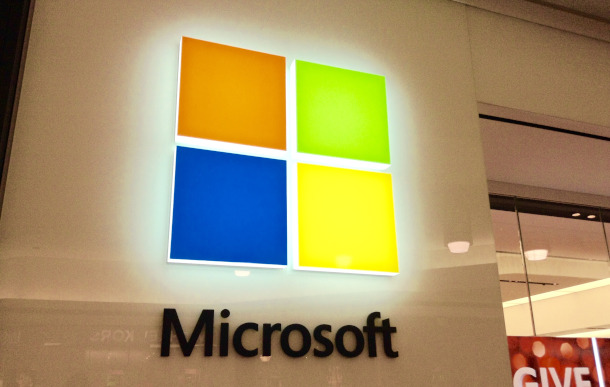
As energy intensive AI technology ramps up, Microsoft is seeking more emissions-free sources of power. (Photo: Mike Mozart, Flickr, CC BY 2.0)
DOERING: And just to be clear, which reactor at Three Mile Island would actually be started back up?
HALPER: So that's an important point. This is not the reactor that partially melted down. That unit shut down after the accident, and it was never reopened. This was a unit that operated right next to that unit and never had a meltdown accident, did not have those problems. It shut down in 2019 mostly because nuclear energy couldn't compete with other cheaper forms of energy, particularly natural gas. I mean, you know, there was the shale boom in Pennsylvania, and natural gas got super cheap, and it just was no longer economic to be selling nuclear power, and so they shut the plant down.
DOERING: And to what extent would this nuclear power make a significant dent in Microsoft's carbon footprint?
HALPER: Well, Microsoft will argue it will make a huge dent, talking about the amount of power that goes to about 800,000 homes. And nuclear power suddenly has great interest in the tech industry because it creates power emissions free. And because there's so much trouble getting enough wind and solar online to meet these surging energy demands that this country is seeing, in large part because of AI, the tech companies are scrambling to find as much zero emissions energy as they can. So, what Microsoft will do here is they'll, they'll use their accounting to say, well, we're purchasing all this clean energy, we're bringing it onto the regional power grid, and because this clean energy would not have been there, but for Microsoft buying this power contract, we get to claim this energy as ours. Whether the electrons actually go to power its data centers is another issue. They actually probably will not. It'll just go onto the grid, but Microsoft is the one bringing that power onto the grid. So, they take credit for zero emissions, even oddly, if they're using energy that's fossil generated from gas or even coal, when they power their data centers. Because they bought all this energy from Three Mile Island, they can claim we're net zero at our data center.
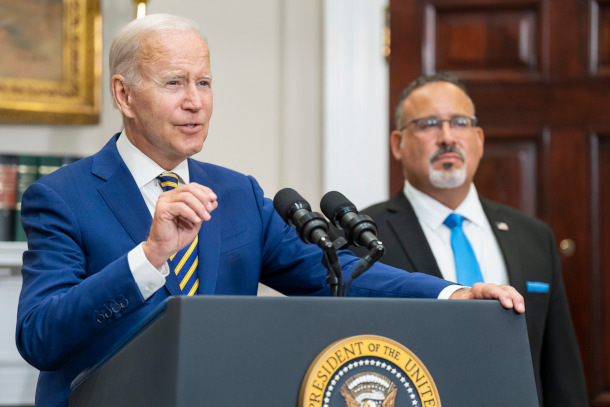
The Inflation Reduction Act, President Biden’s signature climate law, invested heavily in nuclear power. (Photo: Prachatai, Flickr, CC BY-NC-ND 2.0)
DOERING: So, Microsoft is bankrolling the reopening of Three Mile Island by this energy company that runs it, Constellation, and they will have exclusive rights to buy that power. What are some of the concerns with that approach?
HALPER: Well, like all power, but nuclear in particular, a lot of subsidies go into it. One of the reasons that this deal can happen, Constellation is very upfront about this, is because of the Inflation Reduction Act, which was President Biden's signature climate law. That includes really lucrative subsidies for nuclear power. It's a production tax credit. And then it raises the question, were there subsidies intended for the community benefit, or were they intended for one tech company to be able to use them? So that will be a robust debate that we'll be hearing about as the process of trying to reopen this plant moves forward.
DOERING: So how might this setup of a single company buying all this power affect the average energy consumer?

The Three Mile Island partial meltdown in 1979 fueled a wave of anti-nuclear protest across the country. Our guest Evan Halper says we aren’t seeing that same level of pushback this time around. (Photo: Franklin and Marshall College, Flickr, CC BY-NC-ND 2.0)
HALPER: That's one of those questions that we're trying to figure out. And a lot of folks are debating. In this case, Constellation, the owner of the Three Mile Island plant, says, look, we have all the infrastructure in place already, we don't have to order all kinds of new parts and figure out supply chains, it's already there. This will cost about a billion and a half dollars, and we're going to pay for that. We're not asking other rate payers to pay for it. And I talked to Microsoft yesterday, they won't say what exactly they're paying for this power, but it's a higher rate than power off the grid, and they're saying that basically built into the rate is all the costs of the infrastructure to cover all this. But anybody who's looked at the nuclear industry over the years will tell you they never meet their targets for costs, and this has never been done before. They've never taken a nuclear plant that's been headed into decommissioning, been shut down and tried to restart it. And so, we don't know what this process will be like. We don't know how expensive it'll be, and if the cost overruns start to go into the billions of dollars, it becomes a question of, well, who's paying for this? So, there are issues of fairness and a lot of questions about, how will this affect rate payers? How will this affect taxpayers? Is this a fair deal for everyone?
DOERING: So, what are the barriers to getting a closed nuclear power plant going again?
HALPER: Well since it's never been done before, and nothing at the Nuclear Regulatory Commission is simple, you know, what will be involved is a series of federal, state and maybe even local inspections and reviews, so much so that it'll take a few years to make this happen. And then the other part of this is hooking it into the power grid. I mean, one of the big attributes of this project is that they're saying, we're going to hook this into the regional grid, which is, it's called the PJM Interconnect. It's 13 states, and Washington, DC. And right now, getting projects into the PJM interconnect is challenging because, like the rest of the country, the PJM grid has been suffering lack of investment in infrastructure, and it's taking longer and longer to hook in new big power projects. And the question is, will they be able to move as fast as Microsoft and Constellation want them to move to get this project hooked up to the grid and producing power.
DOERING: Right, I mean, it sounds like even if they have all this energy ready to go, this nuclear power plant gets running again, if the grid can't handle it, you know, not much use.

Evan Halper is a business reporter for The Washington Post who covers the energy transition. (Photo: Courtesy of Evan Halper)
HALPER: Yeah, this is a problem that's emerging all over the country. The grid has not had the kind of investment it needs, and that's for a number of reasons. It's not just financial. It's also permitting issues. There's just fights over big transmission projects going across state lines, and for example, in this case, Pennsylvania is going to produce all this energy from Three Mile Island. It's going to be used mostly or purchased by a buyer who has data centers down in Virginia, but that infrastructure needs to carry that power all over the grid, and it becomes a question. Someone in Maryland may say, wait, our rate payers are going to be affected by this, because we may need to build more infrastructure to bring that power down to these data centers in Virginia. Virginia's getting the tax revenue from the data centers. Maryland's getting nothing. What's going on here? We don't like this deal, and these things become really tricky, really fast.
DOERING: Evan, what do you think this move by Microsoft means for the future of powering AI?
HALPER: I think it's a really big deal, and it raises all kinds of questions about the lengths these tech companies will go to to acquire the energy that they say they need. So, when I was at Microsoft yesterday, I was talking to their Energy Lead about, when is this going to stop? When is the growth going to stop? I mean, you just bought an entire nuclear plant's worth of energy, and AI is in its infancy. You're at the front end of this revolution, and you're going to need so much energy to develop this. And the trends we've seen over just like the last couple of years, are not sustainable for much longer. Like, how long is this going to continue? And that's a question they don't like to get, and they don't really give a clear answer to, they express confidence that, well, within five years, things should level off. They talk about how AI itself can make AI more efficient. And you know that all sounds great, and it's true. I mean, AI is much more efficient, or these data centers are run much more efficiently than they were 10 or 20 years ago, but their energy needs are still eclipsing the innovation that is making them more efficient. They're not becoming nearly efficient enough to curb the huge trend lines in energy demand growth.
DOERING: Evan Halper is a business reporter for The Washington Post who covers the energy transition. Thank you so much, Evan.
HALPER: Thank you. It was great to be here.
DOERING: Microsoft provided a statement about its deal with Constellation Energy that reads in part: “The agreement will bring a significant supply of net-new, reliable, carbon-free electricity to the PJM power grid, the regional transmission organization covering 13 states, and complements Microsoft’s 34 GW carbon free energy portfolio of renewable projects across 24 countries.” To read the full statement from Microsoft as well as one from Constellation Energy head to the Living on Earth website, loe dot org.
We have reached out to Constellation Energy for a statement and are awaiting their response.
Microsoft Statement:
“Microsoft and Constellation Energy announced a power purchase agreement (PPA) to restart an 835 MW nuclear facility in Pennsylvania, renamed as the Crane Clean Energy Center (CCEC.) Under the agreement, Microsoft will purchase energy from the renewed plant to help decarbonize the grid in support of our commitment to be carbon negative.
The agreement will bring a significant supply of net-new, reliable, carbon-free electricity to the PJM power grid, the regional transmission organization covering 13 states, and complements Microsoft’s 34 GW carbon free energy portfolio of renewable projects across 24 countries.
For more information about this agreement, and Microsoft’s approach to carbon-free energy, please see the Microsoft Cloud blog.”
Related links:
- Constellation | “Constellation to Launch Crane Clean Energy Center, Restoring Jobs and Carbon-Free Power to The Grid”
- Microsoft Cloud Blog
- Read Evan Halper’s Washington Post article
- Read more about Evan Halper
[BIRDNOTE THEME]
BirdNote®: The Crows' Night Roost
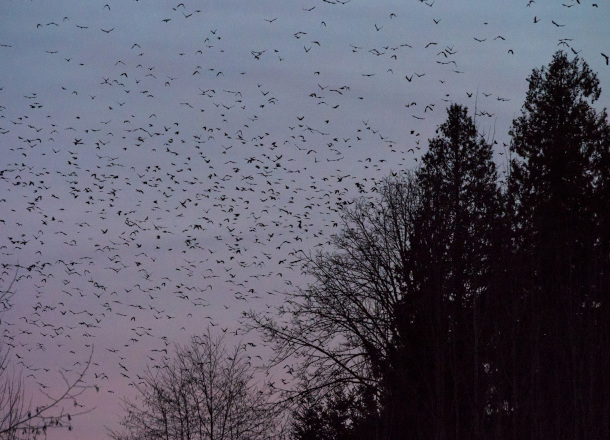
A murder of crows fly through the dusky skies. (Photo: Ingrid Taylar, courtesy of BirdNote®)
O’NEILL: Crows are among the smartest animals around, with the ability to use tools and solve problems. And this all-natural intelligence may have evolved in part to help them thrive in complex social structures. BirdNote’s Ashley Ahearn reports on their communal gatherings.
BirdNote®
The Crows' Night Roost
[Cawing of American Crows]
American Crows stream by overhead in the late afternoon, rivers of crows. These are crows on a mission. They’re headed to their night roost, a giant avian slumber party.
Gathering in a park or woodland, they land in a tree, then scuffle and shuffle and squawk, filtering down through the branches. Birds arriving late force the early birds lower into the trees. Crow experts think the roost may provide benefits like warmth, protection from predators, shared information about food sources, and a chance to find a mate. [Chortles and warbles of the American Crow]
Immature crows may spend the night in the roost year round, but adults of breeding age stay in their own nests while raising their young, then go back to the group after the fledglings leave. [Huge flock of crows builds]

Crow experts think the complex social structures of these birds helped further their relative intelligence. (Photo: Tristan Chambers, CC, courtesy of BirdNote®)
So, just how many crows are there in a roost? That varies, but at one long-time roost in Danville, Illinois, locals have counted more than 100,000 crows! Not that the folks of Danville are especially happy about that. Imagine the ruckus when the first few thousand crows leave in the morning, about an hour before sunrise. [Huge flock of crows]
Follow crows to their roost some autumn evening, if you can, and watch these avian acrobats wheel in for the night. But if you go, just a word of warning: you might want to take an umbrella.
[Cawing of crows]
###
Written by Ellen Blackstone
Producer: John Kessler
Executive Producer: Sallie Bodie
Managing Producer: Jason Saul
Editor: Ashley Ahearn
Associate Producer: Ellen Blackstone
Assistant Producer: Mark Bramhill
Narrator: Ashley Ahearn
Bird sounds provided by The Macaulay Library of Natural Sounds at the Cornell Lab of Ornithology, Ithaca, New York. Call of the single American Crow recorded by G.A. Keller. Flock of roosting American Crows recorded at Foster Island, Seattle, by Martyn Stewart, Naturesound.org. Ambient crow track recorded by C. Peterson.
BirdNote’s theme was composed and played by Nancy Rumbel and John Kessler.
© 2019 BirdNote October 2014 / 2017 / 2019 / 2021 / 2023
ID# roost-02c-2021-10-30 roost-02c
https://www.birdnote.org/listen/shows/crows-night-roost
O’NEILL: For pictures, flap on over to the Living on Earth website, loe dot org.
Related link:
Find this segment on the BirdNote® website
[MUSIC: Joey DeFrancesco, “More Music” on More Music, Mack Avenue Records II, LLC]
DOERING: After the break, transgender scientists can face unique challenges when doing field research. That’s just ahead on Living on Earth. Stay tuned!
ANNOUNCER: Support for Living on Earth comes from Friends of Smeagull the Seagull and Smeagull’s Guide to Wildlife. It’s all about the wildlife right next door to you! That’s Smeagull, S - M - E - A - G - U - L - L, SmeagullGuide.org.
[CUTAWAY MUSIC: Joey DeFrancesco, “More Music” on More Music, Mack Avenue Records II, LLC]
Risks for Transgender Field Scientists
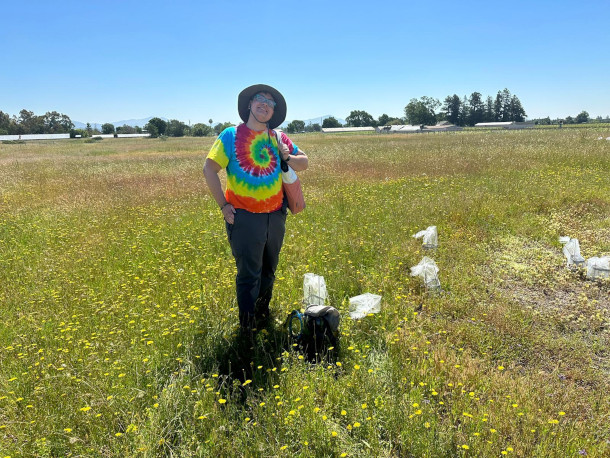
Dr. Kottler works to ensure that the next generation of queer field scientists isn’t deterred by discrimination or lack of infrastructure to support them. (Photo: Nicole Crane, courtesy of Ezra Kottler)
O’NEILL: It’s Living on Earth, I’m Aynsley O’Neill.
DOERING: And I’m Jenni Doering.
As the academic year kicks into full gear, many fresh-faced college students and their professors are heading out into the field to study ecology, biology, geology and more. But for students and scientists who are transgender or gender nonconforming, field research can bring unique challenges and risks. According to a 2022 study from the Williams Institute at UCLA School of Law around 1.3 million U.S. adults identify as transgender. And as trans people gain recognition and visibility in society, academic institutions are encountering issues of access and inclusion, in the classroom and out in the field. Joining us today to talk about those difficulties and how we can minimize them is Dr. Ezra Kottler, a conservation scientist and founder of the Transgender and Gender Nonconforming Field Alliance. Hi Dr. Kottler and welcome to Living on Earth!
KOTTLER: Hi. Thanks so much for having me. I'm really excited to join you today.
DOERING: So, I understand that you identify as nonbinary. What does that mean to you?
KOTTLER: I'm nonbinary, and that means that I don't identify as a man or as a woman. I also identify as transmasculine, so I generally present masculine of center, but my identity is in this gray area between genders, and that is the case for a lot of trans people.
DOERING: So, you came out during grad school. What were you studying then? And what was that like?
KOTTLER: So, I came out as trans and nonbinary halfway through my PhD in marsh plant ecology, and it was an interesting experience. I was preparing to conduct a research project at a field station for six months of the year, and in order to get out of the way introducing myself with my new name and pronouns to as many of the station crew and scientists as possible, we had an all scientists meeting, and I ended up coming out to my PhD advisor, to my lab and to the research station at that meeting. So, it was a big, scary step into this new era of my life, and there were definitely some people who had a harder time receiving it than others, but overall, I felt like most people wanted to just take it in stride and focus on the science, and I was very happy to do that.
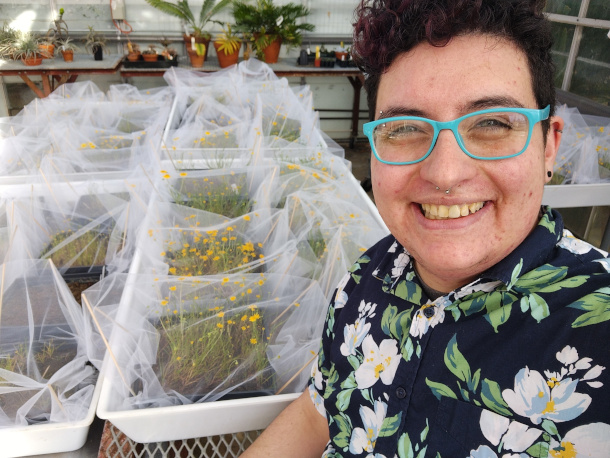
Dr. Ezra Kottler is a Smith Conservation Fellow at University of Colorado, Boulder. They study how plants are responding to the climate crisis. (Photo: Ezra Kottler)
DOERING: Well, what are some of the unique challenges faced by transgender field scientists? Maybe you could walk us through a trip to a field expedition from the perspective of a transgender field scientist.
KOTTLER: So, field scientists do research in remote natural areas all around the world. And so, when field scientists are traveling to a site, they may be getting on an airplane. That will be the first hurdle for a trans field scientist because when you go through TSA and go through the body scanner machine, there is a TSA agent that will look at you and based on a snap judgment of your physical appearance, press a male or a female button that will scan for different body parts based on that assessment. So, if you walk through the machine and there are body parts that weren't expected by the scanning algorithm, you'll be pulled aside for additional screening, which usually involves physical pat down of your body that can feel very scary and invasive for trans people whose bodies don't conform to cisgender norms.
DOERING: Sounds like it adds to what can already be a stressful situation.
KOTTLER: Yes, it definitely does. And so that's the first hurdle. And then when a trans field scientist gets to the region where they're doing their research, this area might have very different laws in place in regards to LGBTQ people than where they live. In many countries, it's still illegal to be gay, and there's very serious legal and safety risks for trans people.
DOERING: Yeah, we've seen a number of so-called bathroom bills popping up in some states across the nation. How do those kinds of laws affect people who are trying to do field research as transgender or nonbinary folks?
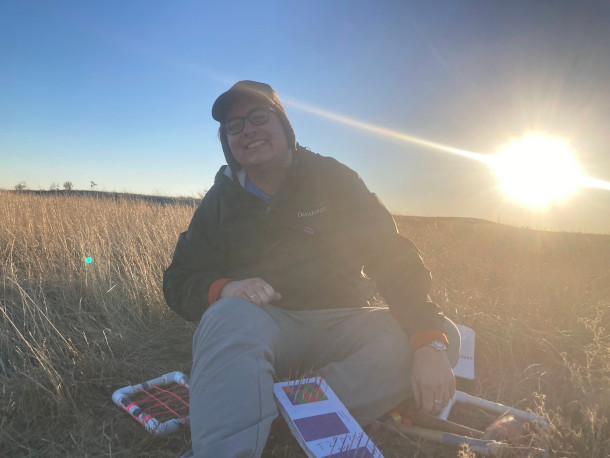
The work of field scientists can be in remote, outdoor areas. (Photo: Sarah Newman, courtesy of Ezra Kottler)
KOTTLER: So, the bathroom bills pose major barriers to trans people safely engaging in public life, and that includes in doing field science. For example, in Utah and Florida, using the bathroom that's in alignment with my presentation and my lived experience could be punishable with up to a year in prison. And so, for example, in my research, I work with endangered plant seeds, and once a year I have to drive a bunch of plant seeds from Colorado, where I'm based, to restoration sites in central California. And given the current legal threats to my safety using public bathrooms in the state of Utah, the last time I made this trip, I went to the bathroom in Wyoming before crossing the border into Utah, and then I drove for five hours straight, and then I used the bathroom on the other side of the border in Nevada. And so, you know, there's actually statistics from the US Transgender Survey, which is the largest survey of trans Americans from 2015, that found that 8% of trans people can get a UTI or other form of infection as a result of avoiding bathroom use in places that are unsafe, so it has very real mental and physical health impacts.
DOERING: So, what are some other physical safety considerations for trans scientists working in field settings?
KOTTLER: Some steps that trans people will take to present authentically in their gender and not be seen as gender-nonconforming or identified as trans in a potentially unsafe environment involve compression garments that may put them at higher risk of heat exhaustion. So, transmen and transmasculine nonbinary people may choose to wear a chest binder, which is kind of like a compression sports bra, but specifically designed to help produce a more flat chest appearance for trans men. And that garment can be very important in keeping someone safe and preventing their identity as trans from being revealed, but the compression means that it can be harder to breathe, and in a hot outdoor environment where you're doing heavy physical labor, can mean that you are at a higher risk of heat exhaustion or other heat related illnesses.

Transmasculine people wear a chest binder to make their chest appear flatter. (Photo: Tommas Gunnarsson, Wikimedia Commons, CC BY-SA 4.0)
DOERING: So, what kinds of resources are there for transgender and gender-nonconforming scientists?
KOTTLER: There are a variety of really great affinity groups for queer scientists that are doing community building. One is the International Society of Nonbinary Scientists, which I joined in 2020 during lockdown. And this is a group with over 500 members across the world, across all different disciplines of science, all identifying as nonbinary. And it was really exciting and affirming to join that group and see that I was a part of this larger community of other nonbinary people navigating STEM workplaces.
DOERING: So, you founded the Transgender and Gender-Nonconforming Field Alliance in 2022. How did that organization come about?
KOTTLER: So, I had been doing organizing work with the International Society of Nonbinary Scientists, but one thing that I hadn't seen addressed as much in that organization, because it's broad to all sciences, was issues that specifically affect trans and nonbinary scientists in field settings. So, there are different challenges for scientists working in laboratory environments, but as we've discussed, there are some very specific challenges when you're working in these remote natural areas. And so, I was really inspired by the leadership of the International Society of Nonbinary Scientists who had just launched that organization on Twitter and had it take off. So similarly, I followed the idea of, if something needs to exist and it doesn't exist, then go ahead and create it. And so, I launched the Field Alliance at the 2022 Ecological Society of America meeting. And since then, we've grown to a membership of over 200 trans and nonbinary field scientists. And part of it is definitely about community building, and then part of it is about creating resources to help allies, to help field institutions and field crew leads to make their workplaces safer and more inclusive of trans field scientists.
DOERING: And so, what steps does the Alliance suggest to institutions to make field science more accessible to trans and gender-nonconforming people?
KOTTLER: So, one of the big things is allowing for privacy for trans and gender-nonconforming people, and setting up the infrastructure at field stations to be more gender inclusive. This includes having gender neutral bathrooms where possible and dorm situations where people don't have to choose between a men's dorm and a women's dorm. And my hope and my goal in the organizing work that I'm doing with my awesome colleagues at the Field Alliance is that we can help create some of the necessary infrastructure and preparation so that new LGBTQ scientists, young students coming to get their first field experience, have a safe and a good experience that makes them want to continue in this field, if it's what they're passionate about. And having diverse scientists with different perspectives and lenses of viewing the world makes for a better and stronger science with more revolutionary advances. And so, the goal behind this is that more scientists can see a future for themselves in these career paths and feel like it is safe enough for them to not just survive but thrive in these workplaces.
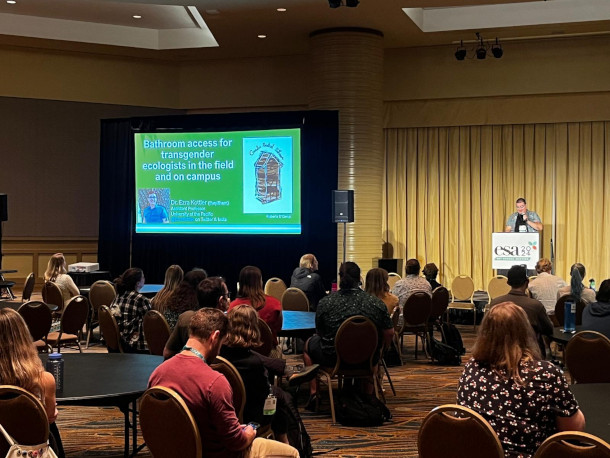
Trans field scientists can find themselves in locations where they are legally prohibited from using the bathroom that aligns with their identity. (Photo: Melissa Cronin, courtesy of Ezra Kottler)
DOERING: Dr. Ezra Kottler is a conservation scientist and founder of the Transgender and Gender-Nonconforming field Alliance. Thank you so much, Dr. Kottler.
KOTTLER: Thank you so much for having me.
Related links:
- Learn about the Transgender and Gender Nonconforming Fieldwork Alliance
- Explore the International Society of Nonbinary Scientists
- Read Dr. Ezra Jay Kottler’s research
[MUSIC: Shea Diamond, “I am America” Single, East West Records LLC]
Tree Swallow Funnel
Tree swallows traveling en masse. (Photo: Mark Seth Lender)
O’NEILL: Here in the Northern Hemisphere, it’s fall migration time, when millions of birds of all sizes travel thousands of miles to warmer lands farther south. One of the smallest and most agile is the tree swallow. Living on Earth’s Explorer in Residence Mark Seth Lender marvels at how these little fliers gather in huge airborne displays.
Tree Swallow Funnel
© 2023 Mark Seth Lender
All Rights Reserved
LENDER: Near the mouth of the Connecticut when the tree swallows are getting ready to go, they make these… Paintings on the sky. Hundreds of thousands, moving together. The shapes change like magic. What looks like mouse becomes fish turns into rabbit and then, a giant lobster complete with claws. Like clouds. But fast. Blink and what you saw is something else. As migration nears, at the morning flyout that’s what they do.
The sun comes up.
They melt away.
Clusters of three and five and maybe a dozen, off to feed on insects that they grasp out of thin air. The eye can barely keep up with them they are so agile, such acrobats in flight.
Tree swallows can form shapes in the sky as they fly. (Photo: Mark Seth Lender)
At dusk they return.
You would think, so much energy spent, they should be ready for bed; not so. They land but then they rise up. The last colors of sunset behind them, like shadow puppets.
Dark descends.
Tree swallows come careening down. Sometimes they form a funnel shape, like a tornado, that same swirling. They come in so fast you can hear them hit the reeds - you barely see them, for the darkness and the speed. And they bed down there for sleep.
This pre-migratory behavior is called a murmuration. Other birds do this. But tree swallows, uncountable, all of them airborne at one time, and the incredible shapes they make, they are unique. Just like us there’s only so close they want to come to each other. They too have what we call Personal Space. This and the span of their wings, creates an inner limit. Which keeps them apart. What keeps them, together – if you look closely, you can see it – hawks and falcons herding the periphery, waiting on those that separate from the murmuration. Safety for tree swallows is in numbers, and coordination. They’re safe as long as they move as one.
An individual tree swallow boasts bright blue plumage. (Photo: Mark Seth Lender)
O’NEILL: That’s Living on Earth’s Explorer in Residence, Mark Seth Lender.
Related links:
- Mark Seth Lender’s website
- Read Mark's field note on this essay
- Special thanks to Estuary Magazine
[MUSIC: Elson Complex, The Bare Bones, “Blooming” Single, Juan Martinez Perez, Steve Downs]
O’NEILL: Living on Earth is produced by the World Media Foundation. Our crew includes Naomi Arenberg, Shanzay Asif, Paloma Beltran, Kayla Bradley, Josh Croom, Karen Elterman, Daniela Faria, Swayam Gagneja, Sommer Heyman, Mark Kausch, Mark Seth Lender, Don Lyman, Nana Mohammed, Sophia Pandelidis, Jake Rego, Andrew Skerritt, El Wilson, and Jolanda Omari.
DOERING: Tom Tiger engineered our show. Allison Lirish Dean composed our themes. Special thanks this week to Estuary Magazine. You can hear us anytime at L-O-E dot org, Apple Podcasts and YouTube Music, and like us, please, on our Facebook page - Living on Earth. We tweet from @livingonearth. And find us on Instagram at livingonearthradio. And you can write to us at comments at loe dot org. Steve Curwood is our Executive Producer. I’m Jenni Doering.
O’NEILL: And I’m Aynsley O’Neill. Thanks for listening!
ANNOUNCER: Funding for Living on Earth comes from you, our listeners, and from the University of Massachusetts, Boston, in association with its School for the Environment, developing the next generation of environmental leaders. And from the Grantham Foundation for the protection of the environment, supporting strategic communications and collaboration in solving the world’s most pressing environmental problems.
ANNOUNCER 2: PRX.
Living on Earth wants to hear from you!
Living on Earth
62 Calef Highway, Suite 212
Lee, NH 03861
Telephone: 617-287-4121
E-mail: comments@loe.org
Newsletter [Click here]
Donate to Living on Earth!
Living on Earth is an independent media program and relies entirely on contributions from listeners and institutions supporting public service. Please donate now to preserve an independent environmental voice.
NewsletterLiving on Earth offers a weekly delivery of the show's rundown to your mailbox. Sign up for our newsletter today!
 Sailors For The Sea: Be the change you want to sea.
Sailors For The Sea: Be the change you want to sea.
 The Grantham Foundation for the Protection of the Environment: Committed to protecting and improving the health of the global environment.
The Grantham Foundation for the Protection of the Environment: Committed to protecting and improving the health of the global environment.
 Contribute to Living on Earth and receive, as our gift to you, an archival print of one of Mark Seth Lender's extraordinary wildlife photographs. Follow the link to see Mark's current collection of photographs.
Contribute to Living on Earth and receive, as our gift to you, an archival print of one of Mark Seth Lender's extraordinary wildlife photographs. Follow the link to see Mark's current collection of photographs.
 Buy a signed copy of Mark Seth Lender's book Smeagull the Seagull & support Living on Earth
Buy a signed copy of Mark Seth Lender's book Smeagull the Seagull & support Living on Earth

